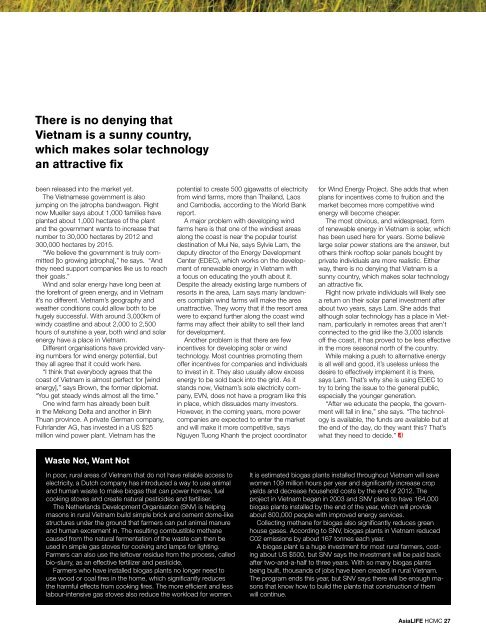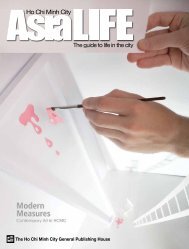You also want an ePaper? Increase the reach of your titles
YUMPU automatically turns print PDFs into web optimized ePapers that Google loves.
There is no denying thatVietnam is a sunny country,which makes solar technologyan attractive fixbeen released into the market yet.The Vietnamese government is alsojumping on the jatropha bandwagon. Rightnow Mueller says about 1,000 families haveplanted about 1,000 hectares of the plantand the government wants to increase thatnumber to 30,000 hectares by 2012 and300,000 hectares by 2015.“We believe the government is truly committed[to growing jatropha],” he says. “Andthey need support companies like us to reachtheir goals.”Wind and solar energy have long been atthe forefront of green energy, and in Vietnamit’s no different. Vietnam’s geography andweather conditions could allow both to behugely successful. With around 3,000km ofwindy coastline and about 2,000 to 2,500hours of sunshine a year, both wind and solarenergy have a place in Vietnam.Different organisations have provided varyingnumbers for wind energy potential, butthey all agree that it could work here.“I think that everybody agrees that thecoast of Vietnam is almost perfect for [windenergy],” says Brown, the former diplomat.“You get steady winds almost all the time.”One wind farm has already been builtin the Mekong Delta and another in BinhThuan province. A private German company,Fuhrlander AG, has invested in a US $25million wind power plant. Vietnam has thepotential to create 500 gigawatts of electricityfrom wind farms, more than Thailand, Laosand Cambodia, according to the World Bankreport.A major problem with developing windfarms here is that one of the windiest areasalong the coast is near the popular touristdestination of Mui Ne, says Sylvie Lam, thedeputy director of the Energy DevelopmentCenter (EDEC), which works on the developmentof renewable energy in Vietnam witha focus on educating the youth about it.Despite the already existing large numbers ofresorts in the area, Lam says many landownerscomplain wind farms will make the areaunattractive. They worry that if the resort areawere to expand further along the coast windfarms may affect their ability to sell their landfor development.Another problem is that there are fewincentives for developing solar or windtechnology. Most countries promoting themoffer incentives for companies and individualsto invest in it. They also usually allow excessenergy to be sold back into the grid. As itstands now, Vietnam’s sole electricity company,EVN, does not have a program like thisin place, which dissuades many investors.However, in the coming years, more powercompanies are expected to enter the marketand will make it more competitive, saysNguyen Tuong Khanh the project coordinatorfor Wind Energy Project. She adds that whenplans for incentives come to fruition and themarket becomes more competitive windenergy will become cheaper.The most obvious, and widespread, formof renewable energy in Vietnam is solar, whichhas been used here for years. Some believelarge solar power stations are the answer, butothers think rooftop solar panels bought byprivate individuals are more realistic. Eitherway, there is no denying that Vietnam is asunny country, which makes solar technologyan attractive fix.Right now private individuals will likely seea return on their solar panel investment afterabout two years, says Lam. She adds thatalthough solar technology has a place in Vietnam,particularly in remotes areas that aren’tconnected to the grid like the 3,000 islandsoff the coast, it has proved to be less effectivein the more seasonal north of the country.While making a push to alternative energyis all well and good, it’s useless unless thedesire to effectively implement it is there,says Lam. That’s why she is using EDEC totry to bring the <strong>issue</strong> to the general public,especially the younger generation.“After we educate the people, the governmentwill fall in line,” she says. “The technologyis available, the funds are available but atthe end of the day, do they want this? That’swhat they need to decide.”Waste Not, Want NotIn poor, rural areas of Vietnam that do not have reliable access toelectricity, a Dutch company has introduced a way to use animaland human waste to make biogas that can power homes, fuelcooking stoves and create natural pesticides and fertiliser.The Netherlands Development Organisation (SNV) is helpingmasons in rural Vietnam build simple brick and cement dome-likestructures under the ground that farmers can put animal manureand human excrement in. The resulting combustible methanecaused from the natural fermentation of the waste can then beused in simple gas stoves for cooking and lamps for lighting.Farmers can also use the leftover residue from the process, calledbio-slurry, as an effective fertilizer and pesticide.Farmers who have installed biogas plants no longer need touse wood or coal fires in the home, which significantly reducesthe harmful effects from cooking fires. The more efficient and lesslabour-intensive gas stoves also reduce the workload for women.It is estimated biogas plants installed throughout Vietnam will savewomen 109 million hours per year and significantly increase cropyields and decrease household costs by the end of 2012. Theproject in Vietnam began in 2003 and SNV plans to have 164,000biogas plants installed by the end of the year, which will provideabout 800,000 people with improved energy services.Collecting methane for biogas also significantly reduces greenhouse gases. According to SNV, biogas plants in Vietnam reducedC02 emissions by about 167 tonnes each year.A biogas plant is a huge investment for most rural farmers, costingabout US $500, but SNV says the investment will be paid backafter two-and-a-half to three years. With so many biogas plantsbeing built, thousands of jobs have been created in rural Vietnam.The program ends this year, but SNV says there will be enough masonsthat know how to build the plants that construction of themwill continue.asialife HCMC 27















